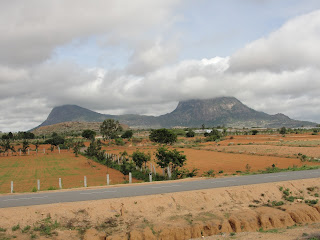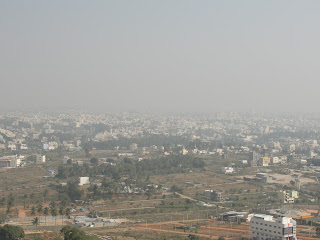Name of the place: Lepakshi
Distance from Bangalore: approx 150 km
Route: Devanahalli , Anantapura road
Duration: 1 day Trip
Road Condition: Good
Best time to visit: October to February
Eatouts : Kamata upachar which on the way
This was one of my most remarkable long drive, as my bike (Bullet) was to complete 1 year and had only 2 long drives in the earlier list. Also, it had been quite some time that we friends met after our exit from our previous company. All of us were awaiting an event which brought us together and the Lepakshi trip was the perfect answer to revive the old memories. The planning started at our very old adda - Sukh Sagar, where we decided on our destination and chalked out the plan with the help of Google. On the D- Day, as planned we met at 6:30 am at the pre-decided place and started by 7:15 am towards the Devanahalli route. The weather was splendid and morning sunshine added a perfect blend for our drive. En-route we stopped at Kamant upchar for a quick breakfast with idli-vada. The sambar was not that great but was enough to satiate our hunger. We reached the Ananthpura toll by 9:00 a.m. and took a small diversion from the main road towards the Lepakshi temple. The road was quite narrow but good as we drove by a scenic pathway. By 9:45 am we reached the destination - Lepakshi.
Lepakshi is a treasure trove of Temples, Paintings and other cultural works of the famed Vijayanagara Empire. The region is famous for its many inscriptions and carvings. There is a Nandi Statue that is located in the village and is one of the main attractions. Many inscriptions in the Kannada language can be seen in the village. Most of these inscriptions date back many centuries. Most of the temples have excellent sculptures. The place is also known for its murals. Veerabhadra temple is a masterpiece and a grand specimen of the Vijaynagara style of architecture. It was built in the mid-16th century by two brothers Virupanna and Viranna, treasury officers of the Penukonda Fort of the Vijaya Nagar Empire. The temple is made up of three sections Mukha Mandapa for dance and other cultural activities, Artha Mandapa for worship and the Garbha Griha housing the deity. There is also a 'Kalyana Mandapa', or Wedding Hall made from grey sandstone with 38 carved monolithic pillars. Legend has that Lord Shiva and Parvati got married at this Kalyana Madapam!
The journey then on is explained through the pictures below:
 |
The scenic beauty of the Nandi Hills covered by mist, seen en-route
|
 | |
Our very own companions to our destination
|
 | |||||
| The Veerabhadra temple Gopuras |
 |
The monolith statue of Nagalinga, a Shiva Linga with a multi hooded Naga serpent over it. Legend has that this sculpture was created by workers in less than an hour, while they were waiting for their lunch to be served!
Another architectural marvel is the open entrance Kalyana Mantapa, behind the temple. The sculptor here depicts the wedding of lord Shiva and Goddess Parvathi - one of the best of its kind. However this Kalyana mantap was un-finished due to the financial crunch faced by the later empires.
 |
| The entrance of the open Kalyana Mantapa |
 |
| The inside view of the Kalyana Mantapa |
 The enchanting mural paintings on the ceiling of the temple is a treat to the eyes | ||||||
One of the beautiful mural paintings is that of the Lord Krishna , which is unique because irrespective of the direction in which you view this painting you can still see that the painting smiles at you.
Moving around inside the temple, you can spot one of the most remarkable architecture of the ancient days. It is known as the “Hanging Pillar” and true to its name this pillar does not touch the ground. History believes that the Britishers were curious to know the scret of the construction and tried to move the pillar, which resulted in all the surrounding 600 pillars being disturbed. This is considered to be the main pillar of the temple.
| The picture above clearly captures the space between the pillar and the ground |
 | ||
| “Hanging Pillar” |
Sculpture of Lord Ganesha
The Mural paintings of Lepakshi with their natural pigments, have actually spun off a new style of textiles called Lepakshi Motif. The designs depicted in the murals are the famous block printed textiles and rugs which we can find today.
|
 | |
 | |
| A beautiful carving of a cow |
 | |
| The carving of the Dance Guru of the Gods. Observe the 3 legs which he has, resulting in him dancing all the time. |
 | |
| Imprint of the plate that was being used in the 16th century |
 | |
| Place where Chandika Homa is performed in the temple |
 | ||
| Vishala Sabha |
Travelling a little beyond of 500 mts from the temple you can see the huge monolithic statue of Nandi, which is considered to be one of the biggest in india. This is unique to the fact that the Nandi is placed exactly opposite to the Nagalinga, in the Lepakshi temple. An amazing architectural design
 | ||
Monolithic Nandi : 15ft tall and 27ft length
|
On the way back, we chanced on this scenic spot near Doddaballapura, which is not been exposed to many of the travelers. All credit to my friend who managed to discover this place.
With the dusk and the setting of the sun, birds retreating back to their nests, we rode back to Bangalore, cherishing one of the best drives that I have ever had. :)



































